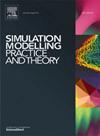利用区块链技术在计算机上模拟物流过程
IF 3.5
2区 计算机科学
Q2 COMPUTER SCIENCE, INTERDISCIPLINARY APPLICATIONS
引用次数: 0
摘要
区块链因加密货币的发展而为公众所知。然而,区块链和区块链技术在各个领域的应用具有更大的可能性。其中一个领域是供应链和物流中的计算机模拟。将仿真模型集成到区块链中,可以呈现物流与区块链应用之间的联系。本研究的基础是一个基于物流原理的生产线仿真模型。本研究的主要目标是使用区块链来记录、存储和验证生产过程中与供应相关的物流过程仿真模型的真实性。通过主动配合仿真模型及其频繁的供应链和物流修改,是一种具有重要应用可能性的解决方案。同时,该功能在未来可以直接集成到仿真工具中。研究证实了仿真模型和仿真实验结果可以安全地写入和存储在区块链中,保证了其有效性、可验证性和可信度。所获得的结果以验证的形式在区块链中记录仿真模型,利用区块链对仿真模型进行验证及其下载的可能性,为其应用扩展到物流计算机仿真领域和物流应用领域创造了先决条件。本文章由计算机程序翻译,如有差异,请以英文原文为准。
Using blockchain technology in the computer simulation of logistics processes
Blockchain became known to the public in connection with the development of cryptocurrencies. However, blockchain and blockchain technology have much greater possibilities for use within various areas. One of these areas is computer simulation in supply chain and logistics. Integrating the simulation model into the blockchain can present the connection between logistics and blockchain applications. The base of the study was a simulation model of a production line modelled on the logistics principle. The primary goal of this study is to use the blockchain to record, store and verify the authenticity of the simulation model of the logistics process associated with supply in the production process. It is a solution with significant application possibilities through active work with the simulation model and its frequent supply chain and logistics modifications. At the same time, this functionality could be directly integrated into simulation tools in the future. The study confirmed that the simulation model and the results of simulation experiments can be securely written and stored in the blockchain, ensuring their validity, verifiability and trustworthiness. The obtained results in the form of verification of the recording of the simulation model in the blockchain, the use of the blockchain for the validation of the simulation model and the possibility of its download create a prerequisite for its application extension to the field of computer simulation for logistics and application fields of logistics.
求助全文
通过发布文献求助,成功后即可免费获取论文全文。
去求助
来源期刊

Simulation Modelling Practice and Theory
工程技术-计算机:跨学科应用
CiteScore
9.80
自引率
4.80%
发文量
142
审稿时长
21 days
期刊介绍:
The journal Simulation Modelling Practice and Theory provides a forum for original, high-quality papers dealing with any aspect of systems simulation and modelling.
The journal aims at being a reference and a powerful tool to all those professionally active and/or interested in the methods and applications of simulation. Submitted papers will be peer reviewed and must significantly contribute to modelling and simulation in general or use modelling and simulation in application areas.
Paper submission is solicited on:
• theoretical aspects of modelling and simulation including formal modelling, model-checking, random number generators, sensitivity analysis, variance reduction techniques, experimental design, meta-modelling, methods and algorithms for validation and verification, selection and comparison procedures etc.;
• methodology and application of modelling and simulation in any area, including computer systems, networks, real-time and embedded systems, mobile and intelligent agents, manufacturing and transportation systems, management, engineering, biomedical engineering, economics, ecology and environment, education, transaction handling, etc.;
• simulation languages and environments including those, specific to distributed computing, grid computing, high performance computers or computer networks, etc.;
• distributed and real-time simulation, simulation interoperability;
• tools for high performance computing simulation, including dedicated architectures and parallel computing.
 求助内容:
求助内容: 应助结果提醒方式:
应助结果提醒方式:


